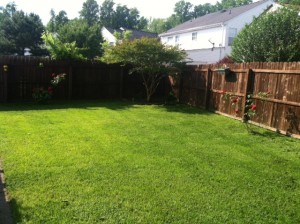Every spring, all homeowners in my neighborhood receive a notice that they must weed, feed and overseed their lawns. This letter is cringe-worthy. Why, you ask? Well, excess lawn chemicals are one of the top polluters to our local waterways. When too much or needless chemicals are applied to lawns and landscapes, spring rain showers carry them into our neighborhood stormwater ponds or local waterways. In my neighborhood, the association notice to weed, feed and overseed is typically followed by the stormwater ponds in our neighborhood turning green, cloudy and covered in slime (aka algae). The same thing is happening to our rivers and the Chesapeake Bay, albeit on a larger scale, as homeowners across the east coast try to green up their lawns in early spring.
So what’s the best course of action if and when you get the “You Must Fertilize” notice in your mailbox?
- Know Your Grass. If your grass is in full sun and turns brown at the first signs of frost, you likely have warm season grasses that like fertilizer applications early in the spring. However, if your grass grows well most of the year except in the extreme heat of summer, you probably have cool season grass which likes fertilizer in the fall. According to the Virginia Cooperative Extension, Hampton Roads is better suited for warm-season grasses but the predominant lawn grass continues to be the cool-season tall fescue.
- Test Your Soil. Follow these simple steps to collect a soil sample from your lawn and then have it tested. This simple, low or no cost testing will tell you whether or not you need to fertilize to have healthy grass. Soil here in Hampton Roads tends to be naturally fertile making the process of fertilizing a costly mistake – both on our budgets and our local water quality. If extra nutrients are recommended, your report will also help you learn how much chemical is safe to put down. Contact your local Virginia Cooperative Extension Office for more information.
- Consider natural alternatives. Fertilizing doesn’t have to be your standard off-the-shelf bag of chemicals. Learn more about incorporating compost, mulched yard debris or other natural sources of fertilizer.
- Practice patience. Mother Nature will work her magic but you must be patient. Let the temperatures warm up, let the April showers drench your lawn and by mid-May you’ll be surprised how much progress your lawn has made naturally. Grass roots need a little time to grow before they can fuel green blades of grass. And stronger, deeper roots mean a more resilient (and less thirsty) lawn during the dry spells of summer. So don’t even consider fertilizer until April (for warm season grasses) or September (for cold season grasses).
Keep reading for more good-to-do tips for an eco-friendly (and attractive) lawn this summer!
Not a do-it-yourselfer? Ask these questions to your lawn care provider to make sure your grass is as “green” as you think!
